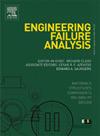弯曲荷载作用下混凝土刚性法兰节点破坏模式及设计方法
IF 4.4
2区 工程技术
Q1 ENGINEERING, MECHANICAL
引用次数: 0
摘要
为研究刚性法兰混凝土节点在弯曲荷载作用下的弯曲性能,设计了2个刚度相同的法兰混凝土节点试件,进行了四点弯曲试验和数值模拟分析。在试验和模拟中,得到并分析了其破坏模式、荷载-位移曲线、开口变形和应变发展。通过24次数值模拟分析,揭示了混凝土填充率β、法兰厚度Tp、加强筋高度Hs和螺栓数N对极限弯曲承载力和旋转轴位置的影响。结果表明:CFRF节点的破坏模式为最大应力螺栓破坏、混凝土开裂、法兰板v形开口,表明螺栓撬撬力的发展;螺栓撬撬力从拉伸侧向压缩侧逐渐减弱。此外,CFRF节点的极限弯曲承载力和旋转轴位置与β、Tp、Hs和n呈正相关。最后,基于单网格的变形特征,提出了CFRF节点周向刚度的计算理论,提出了5种典型破坏模式和设计方法。本文章由计算机程序翻译,如有差异,请以英文原文为准。
Failure mode and design method for concrete-filled rigid flange (CFRF) joints under bending load
To study the bending behaviour of concrete-filled rigid flange (CFRF) joint under a bending load, two CFRF specimens with the same stiffness were designed, and four-point bending tests and numerical simulation analyses were conducted. In the tests and simulations, the failure mode, load–displacement curve, opening deformation and strain development were obtained and analysed. Furthermore, 24 numerical simulation analyses were conducted to reveal the effects of the concrete-filling rate β, flange thickness Tp, stiffener height Hs, and bolt number N on the ultimate bending bearing capacity and position of the rotation axis. The results indicate that the failure mode of the CFRF joint involves damage to the maximum-stress bolt, concrete cracking, and V-shaped opening on the flange plate, indicating the development of a bolt prying force. However, the bolt prying force gradually weakens from the tensile to the compressive side. In addition, the ultimate bending bearing capacity and rotation axis position of the CFRF joint are positively correlated with β, Tp, Hs, and N. Finally, based on the deformation characteristics of a single grid, a theory for calculating the circumferential stiffness of the CFRF joint presented, and five typical failure modes and the design methodology are proposed.
求助全文
通过发布文献求助,成功后即可免费获取论文全文。
去求助
来源期刊

Engineering Failure Analysis
工程技术-材料科学:表征与测试
CiteScore
7.70
自引率
20.00%
发文量
956
审稿时长
47 days
期刊介绍:
Engineering Failure Analysis publishes research papers describing the analysis of engineering failures and related studies.
Papers relating to the structure, properties and behaviour of engineering materials are encouraged, particularly those which also involve the detailed application of materials parameters to problems in engineering structures, components and design. In addition to the area of materials engineering, the interacting fields of mechanical, manufacturing, aeronautical, civil, chemical, corrosion and design engineering are considered relevant. Activity should be directed at analysing engineering failures and carrying out research to help reduce the incidences of failures and to extend the operating horizons of engineering materials.
Emphasis is placed on the mechanical properties of materials and their behaviour when influenced by structure, process and environment. Metallic, polymeric, ceramic and natural materials are all included and the application of these materials to real engineering situations should be emphasised. The use of a case-study based approach is also encouraged.
Engineering Failure Analysis provides essential reference material and critical feedback into the design process thereby contributing to the prevention of engineering failures in the future. All submissions will be subject to peer review from leading experts in the field.
 求助内容:
求助内容: 应助结果提醒方式:
应助结果提醒方式:


